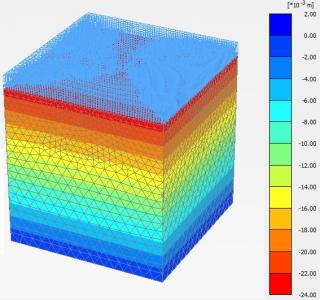
Expanded polystyrene (EPS) geofoam is an interesting area in the field of geotechnical engineering and its service life is comparable to other construction materials. With different geotechnical applications of EPS geofoam involving submergence, underlying compacted soil and higher structural loads, creep deformation under compression pressure have been occurring. In this study, an attempt was made to investigate the behavior of compression creep of EPS geofoam through Plaxis 3D software. The EPS geofoam blocks used in the experimental study for validation purposes consisted of three different densities of 12, 15, and 20 kg/m3 under the applied pressure of 65% of the compressive strength at 5% strain level of 12 kg/m3 density of geofoam. For each density of EPS geofoam cube with a size of 100 mm was considered. The EPS geofoam was modeled using a MohrCoulomb nonporous material. As the stress-strain behavior of EPS is close to linearly elasticperfectly plastic material. The fine option is selected as the element distribution. All properties of EPS geofoam except Poisson’s ratio used in the numerical modeling were determined in the laboratory. For the finite element analysis, the consolidation time of 220 days was considered similar to laboratory creep test time. All the displacement on the horizontal boundary and the bottom surface were arrested, whereas allowed to undergo vertical displacement.
The finite element analysis results validating with the experimental data.A good agreement was observed on axial strain-time response between experimental and numerical investigations. The numerical results revealed that with the increase in density of EPS geofoam, creep deformation value decreases but on low-density EPS geofoam the effects of creep deformations were more noticeable. The average variation between experimental and finite element analysis results of EPS geofoam creep strain was 28%. This could be the Poisson’s ratio of EPS geofoam for this analysis was estimated by using the empirical equation from the previous study. The finite element analysis results showed that the creep strain of EPS geofoam increase with an increase in the duration. It is also observed this variation is the same for all the densities of EPS geofoam
Prof. J N Mandal
